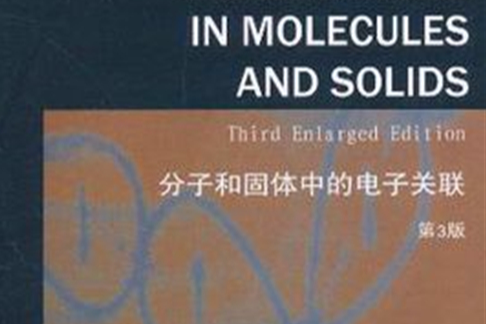《分子和固體中的電子關聯》是2011年由世界圖書出版公司出版的圖書,作者是德國福爾德(P.Fulde)
基本介紹
- 中文名:分子和固體中的電子關聯
- 作者:福爾德
- 出版時間:2011年4月1日
- 出版社:世界圖書出版公司
- 頁數:480 頁
- ISBN:9787510033049
- 開本:24 開
- 裝幀:平裝

《分子和固體中的電子關聯》是2011年由世界圖書出版公司出版的圖書,作者是德國福爾德(P.Fulde)
《分子和固體中的電子關聯》是2011年由世界圖書出版公司出版的圖書,作者是德國福爾德(P.Fulde)作者簡介作者:(德國)福爾德(P.Fulde)內容簡介《分子和固體中的電子關聯(英文版)》用獨特的方法講述分子和固體中...
假定1在固體與分子中,每個原子一般由兩種原子狀態雜化而成。這兩個狀態將叫做h態和t態,其中至少有一個在基態或靠近基態的激發態。兩個狀態都有它們自己的共價電子數nc,“晶格電子”數nl和單鍵半距R( l )。假定2一般情況下,狀態雜化是不連續的。若ct表示了t態成分,那么在多數結構中ct將由或近似地將由...
具體地,我們使用最佳化的量子化學DMRG方法精確計算少電子體系如原子,分子,量子點等系統中的電子關聯效應,解決這類系統中的一些基本問題如洪特規則的物理本質,電子如何從高密度的液體演化到低密度的固體,以及在這個過程中電子性質的變化。這些問題的解決有利於研究更複雜系統的電子關聯問題。結題摘要 凝聚態物理中的...
根據配位結構特點,用低維配合物進行結構可控的分子材料組裝,研究結構與磁性、發光及能量傳遞規律。利用無機固體電子結構多樣性的特點,進行分子固體材料設計與定向合成。考察低維固體嵌入化學的結構定向性,探討複合材料中有機無機化合物的相互作用及協同效應。該研究對發現新材料,進一步合成設計三維有序功能材料有重要...
作為 《導電高分子中的電子關聯》 課題主研人員獲1990年中國科學院自然科學一等獎。2000年被評為“做出突出貢獻的四川博士學位獲得者”,受到四川省教育廳、省學位辦表彰。1988年以來一直擔任凝聚態物理研究生課程《固體理論》、《計算物理學》和《低維物理》等課程教學,指導研究生碩士學位論文。科研項目 1、1995-1998...
磁性分子固體材料是近年才發展起來的一種新型功能材料。從學術上講,由於沒有金屬離子作為順磁中心,對其研究將會豐富現有磁性理論. 從套用角度看,其磁性表現在分子水平上,有希望通過化學合成而控制其結構, 做成分子器件。對於磁性系統,由於電子關聯作用與磁受挫間的合作與競爭,系統會出現金屬、絕緣體、鐵磁態、反鐵...
第一部分:理論;(1)簡介;(2)空間群和晶體結構;(3)晶體軌道的對稱性和局域化;(4)周期系統的Hartree–Fock LCAO方法;(5)分子和晶體中的電子關聯;(6)分子和周期系統中的半經驗LCAO方法;(7)周期系統中的Kohn–Sham LCAO方法;第二部分:套用;(8)周期性LCAO計算中的基礎集和贗勢;(9)理想...
結合電子動量譜學和其他相關的實驗技術以及理論方法有助於我們更準確、更全面地理解物質的電子運動規律和電子結構。經過近四十年的發展,電子動量譜學作為研究原子、分子和固體薄膜等物質的電子態結構和電離機制的一種強有力工具,已經成為物理、化學、生物、材料和醫藥等多學科交叉的一個前沿領域,對電子關聯效應、相對...
正電子湮沒過程是一個量子電動力學的過程,它的理論分析需用量子電動力學的理論。根據量子電動力學理論及場論的分析可知,正負電子湮沒時可以發射單光子、雙光子和三光子,但發射雙光子的機率最大。形成與湮沒 在分子固體、液體和氣體中,正電子的湮沒行為最顯著的特徵是正電子與電子可以結合成一種最輕的亞穩態原子...
·生物大分子的結構、功能與性質 研究目標 ·進行與材料設計有關的電子結構和物性的計算 ·模擬和預測材料的動力學性質 ·介觀量子輸運理論研究 ·揭示新型電子材料的物理規律 ·計算方法上進行創新以適應新問題的需要 研究領域 ·電子結構研究 ·納米量子輸運研究 ·強關聯電子體系理論 ·動力學模擬 功能材料研究室 ...
同時,為了方便讀者使用,本書專門列有附錄,詳盡給出了各種必要的數學工具以及多電子體系的量子計算方法。本書適合於物理、化學、生物及交叉領域從事理論計算與實驗研究的,特別是進行分子間相互作用研究的研究人員參考,教師與研究生是本書的主要讀者對象。前言 本書的主題——分子間相互作用——在化學、分子生物學...
高分子固體電解質指載流子為止負離子,材料中不存在任何液體物質的導電高分子材料。常見的有含鑊離子的聚環氧乙烷和聚環氧丙烷由r與電子相比,離子的體積較大,在電場作用下需要有一定空間條件才能作定向遷移,因此,聚合物具有一定柔性和郭彈性是必要的,因此高分子電解質必須在其玻璃化轉變溫度以上使用-同時為一r能使...
在凝聚態物體中,自由正電子湮沒的平均壽命在(1~5)×10-10s範圍內。正電子湮沒壽命譜(PALS)常被用來研究固體中的缺陷,尤其是半導體中的空位型缺陷。鄰位正電子的壽命取決於184個鄰位正電子的壽命,而鄰位正電子的壽命受鄰位正電子周圍空位缺陷的影響。因此,PALS可以看作是一種時域特徵描述技術。雙γ角關聯 ...
凝聚態物理學(condensed matter physics)是研究凝聚態物質的物理性質與微觀結構以及它們之間的關係,即通過研究構成凝聚態物質的電子、離子、原子及分子的運動形態和規律,從而認識其物理性質的學科。凝聚態物理學是當今物理學最大也是最重要的分支學科之一。一方面,它是固體物理學的向外延拓,使研究對象除固體物質以外...
(4)一個開殼層離子(一般是正離子)與多個閉殼層離子(或分子),如過渡金屬配合物M(X⁻)ₘ,它們之間形成配位鍵(屬共價鍵範圍)。(5)許多金屬原子聚集在一起,最外層價電子脫離核的束縛,在整個金屬固體內運動——金屬鍵。討論這些成鍵原理的理論稱為化學鍵理論。研究化學鍵的理論方法 典型的化學鍵可歸納為...
我們知道,不論任何物體,構成物體的分子或原子之間存在著間隙、原子核與電子之間也存在間隙。因此,一個物體就是由懸浮於空間中的各級粒子通過不同作用關係逐級構成的一個鬆散結構的聚合體。一方面,根據接觸的相對性原理,任何物體或粒子之間的相互作用都是在一定間隙下通過場傳遞的。也就是說,無論一個粒子與某個...
除了上述三種物態以外,有人增加了等離子態、超固態和玻色-愛因斯坦凝聚態。當氣體中分子運動更加劇烈,成為離子、電子的混合體時,稱為等離子態;當壓強超過百萬大氣壓時,固體的原子結構被破壞,原子的電子殼層被擠壓到原子核的範圍,這種狀態稱為超固態;有些原子氣體被冷卻到納開(10K)溫度時,被稱為氣體原子(...
以密度泛函理論(DFT)方法為代表的量子化學方法,已廣泛套用於化學材料的電子結構與性質的研究。然而,傳統方法難以準確描述過渡金屬等具有強電子-電子相互作用(強關聯效應)的體系。動力學平均場理論(DMFT)可合理處理電子關聯作用,並已在周期性固體材料的研究中取得成功,而適用於單分子磁體、過渡金屬團簇等化學體系...
熱傳導(又稱為導熱)是指當不同物體之間或同一物體內部存在溫度差時,就會通過物體內部分子、原子和電子的微觀振動、位移和相互碰撞而發生能量傳遞現象。不同相態的物質內部導熱的機理不盡相同。氣體內部的導熱主要是其內部分子做不規則熱運動是相互碰撞的結果;非導電固體中,在其晶格結構的平衡位置附近振動,將能量...
25.'σ和σ-π共軛高分子的導電機理研究 26.改性鎳酸鋰的電子結構計算及電化學性能研究 27.利用生物強化技術處理含氯酚難降解廢水研究 28.油田含聚廢水高效好氧生物處理工藝的研究 29.新型改性脂肪胺固化劑的合成 30.關於LC/MS在農作物產品中農藥殘留量檢測中的套用研究 31.高分散系高傳質好氧生化技術及設備處理...
